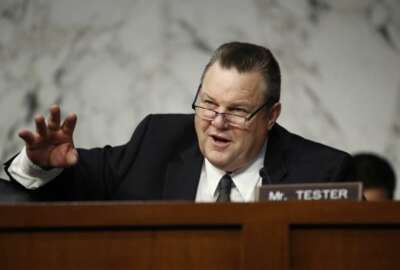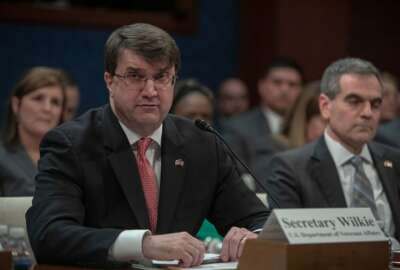

Congressional appropriators are concerned about the Department of Veterans Affairs' plans to implement and pay for the VA MISSION Act, which may likely place more...
Best listening experience is on Chrome, Firefox or Safari. Subscribe to Federal Drive’s daily audio interviews on Apple Podcasts or PodcastOne.
As federal agencies and appropriators face a tough year of budget standoffs in the coming months, the Department of Veterans Affairs is preparing for its own funding battle.
VA in the next few months will attempt to ease concerns from some members of Congress, who fear the department won’t have enough discretionary funds to pay for the new, consolidated community care programs authorized in the VA MISSION Act — without diverting agency resources to the private sector.
The President signed the VA MISSION Act into law last June. Though it was initially lauded by the Trump administration, Congress and veterans service organizations, some had raised concerns early on about how the department would physically pay for the community health care program.

In passing the MISSION Act, lawmakers moved the VA’s community care programs from mandatory to discretionary spending, meaning that whatever amount Congress does appropriate for fiscal 2020, it must fit within overall domestic spending caps.
“VA will need a sustainable funding stream that continues to support core VA programs, and I absolutely do not want to see community care funded at the expense of traditional VA medical services,” Rep. Debbie Wasserman Schultz (D-Fla.), chairman of the House Appropriations Military Construction and Veterans Affairs Subcommittee, said at a Tuesday hearing.
All of this comes as the department has proposed new criteria for allowing veterans to see a private provider over a VA doctor. The department’s proposed regulations, which are open now for public comment, suggest veterans can see a community provider if they’ve been waiting for more than 20 days for primary, mental health and non-institutional extended care services, or if they face a 30-minute drive to the nearest VA facility.
Average drive and wait times tick up to 60 minutes and 28 days for certain kinds of specialty care under VA’s new proposed regulations.
The previous legislation, the Veterans Choice, Accountability and Transparency Act of 2014, allowed veterans to visit a community provider if they lived 40 miles away from the closest VA medical facility or if they had been waiting 30 days or longer for VA care.
According to Wasserman Schultz, 8 percent of enrolled veterans are eligible to receive community care under the existing access standards. With VA’s proposed standards, 20 percent of enrolled veterans will be eligible to receive primary care and 30 percent will be eligible for specialty care outside the department, she added.
“How are you not going to have an explosion of costs here, and how are we not going to be driving veterans out of the VA system?” she said, holding up a chart that illustrated the department’s proposed paths for a veteran to receive community care.




“What that chart shows you is not a deliberate path to privatization,” he said. “No one has advocated for that. This Congress certainty didn’t intend that, and I do not intend that. What that does meet is the mandate of … the MISSION Act, which says that the interest of the veteran will be central to any decision that we make. If we are unable to provide a certain service to that veteran, that veteran then has the choice to go into the private sector to receive that particular type of care. It doesn’t mandate that we are turning veterans out into the street.”
But Democrats have, and will likely continue, to be skeptical. Rep. Mark Takano (D-Calif.), chairman of the House VA Committee, has already expressed his concerns over VA’s proposed access standards. He’ll lead a hearing Wednesday on VA’s vision for the next 10 years. Wilkie is expected to testify on the changing needs and demographics of the veteran population, but VA’s proposed access standards are sure to be a topic of discussion.
VA’s ongoing struggle to fill vacancies, particularly those in medical fields, is contributing to lawmakers’ concerns about the department’s plans for community care.
While Congress has been amenable to VA’s budget requests in recent years, Democrats in particular fear discretionary dollars will ultimately go to community care providers, not hiring more employees to the department.
VA has 48,985 vacancies, nearly 43,000 of which are at the Veterans Health Administration, according to recent data the department published earlier this month to comply with MISSION Act reporting requirements.
Wilkie said VA’s vacancy challenges mirror those in the broader health care community.
“I would be lying to you if I said I’m going to look to fill all those vacancies,” Wilkie said. “What I need to focus on … is where we have the greatest need: primary care, women’s health, mental health and nursing.”
According to the department, VA has a 9 percent turnover rate, which the Office of Personnel Management said rates comparatively to other federal agencies.
“If in fact our vacancies were affecting wait times we’d be very concerned,” Richard Stone, the executive performing the duties of the agency’s health undersecretary, said. “But our wait times are actually reducing across our entire delivery system.”
House appropriators also had questions about VA’s $16 billion, 10-year-implementation effort of a new electronic health record.
The 10-year timeline was of particular concern, particularly for Rep. Will Hurd (R-Texas).
Wilkie said the timeline was a “projection.” But Stone said the project’s 10-year outlook is mostly due to the challenges of reconciling 131 instances of its current electronic record, the Veterans Information Systems and Technology Architecture (VistA).
“There are 131 data sets that go back decades, that must be not only data-mapped, but must be combined into a single instance before you can migrate the data over into the Cerner product,” Stone said. “This is not simply about bringing an electronic medical record to life, this is about moving from a highly disjointed system without data integration, to one that’s fully data-integrated and therefore interoperable.”
Stone said Cerner’s team had mapped all VistA instances for the EHR transition.
“I am glad that you know there’s 131 instances of VistA, because two years ago we didn’t know that number,” Hurd said. “That is a sign that we’re moving forward, so this is probably the first time that I have been encouraged about the movement.”
Copyright © 2025 Federal News Network. All rights reserved. This website is not intended for users located within the European Economic Area.
Nicole Ogrysko is a reporter for Federal News Network focusing on the federal workforce and federal pay and benefits.
Follow @nogryskoWFED
